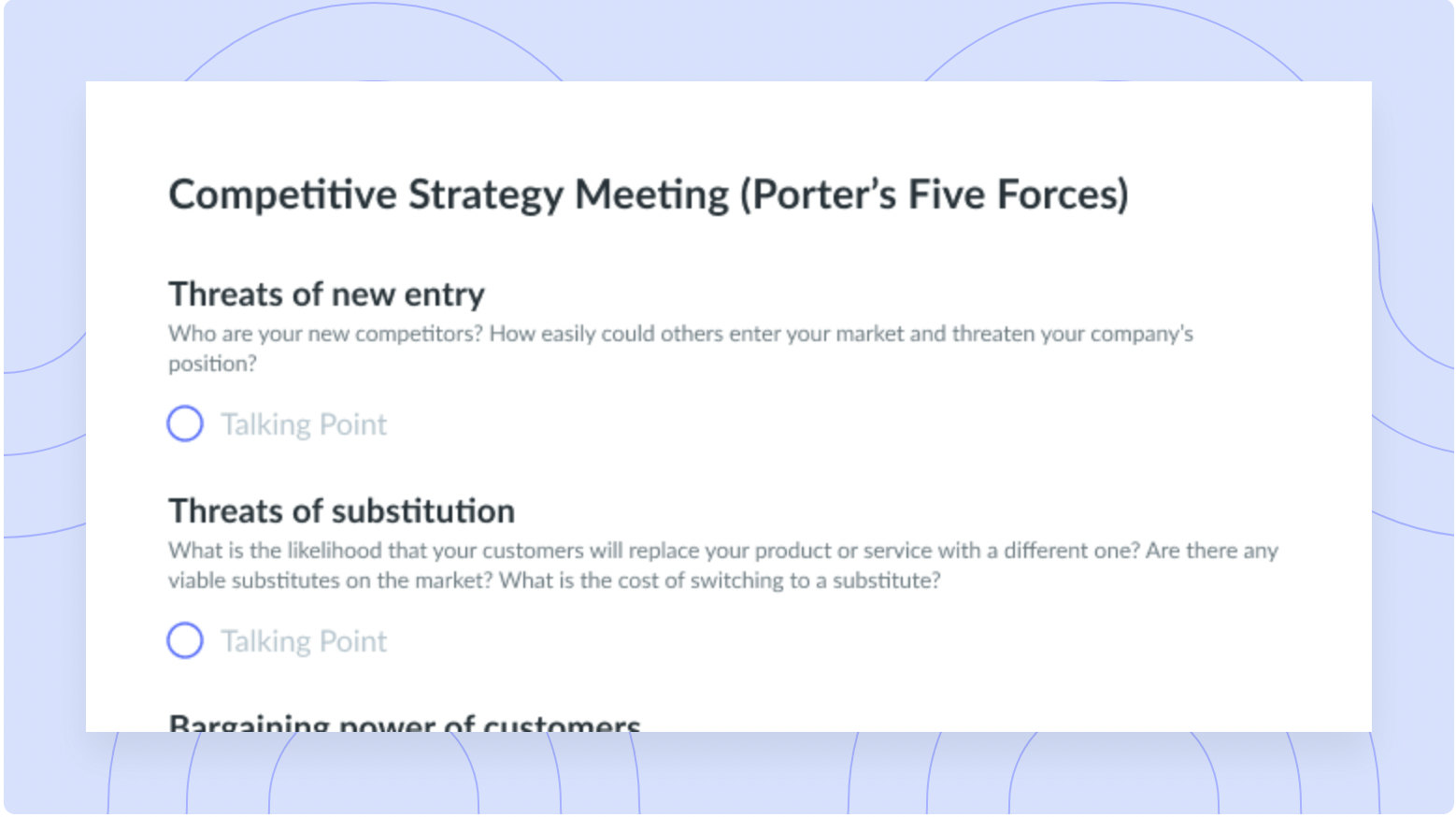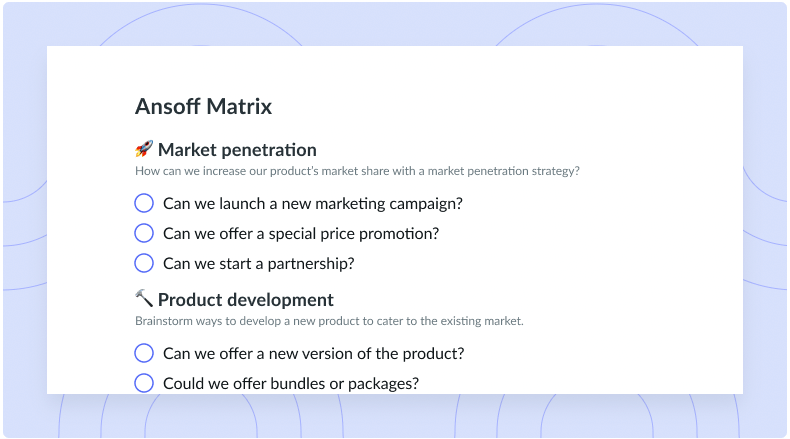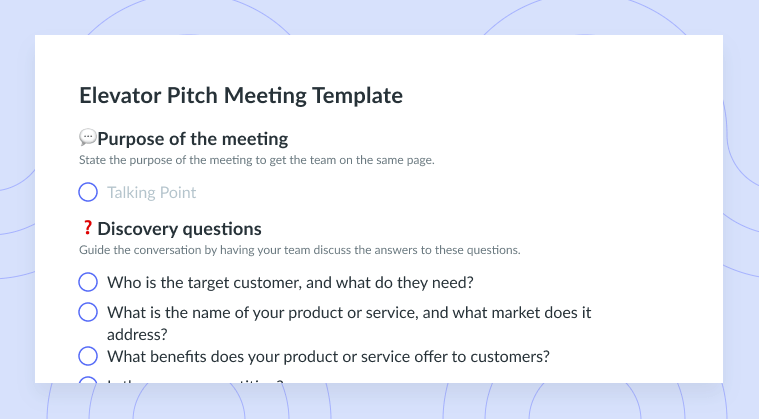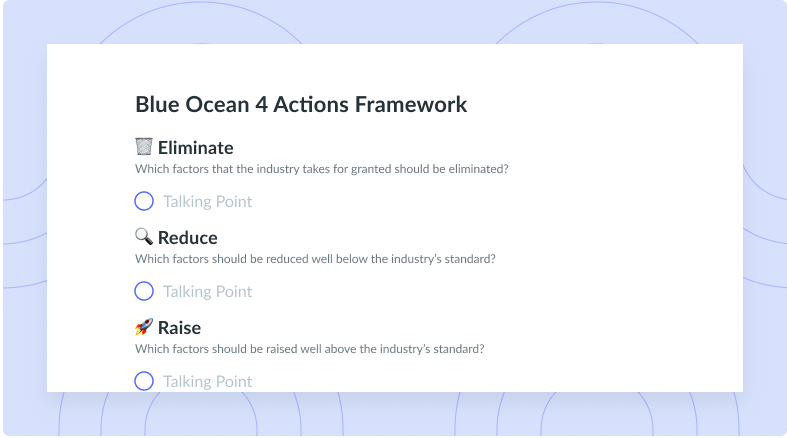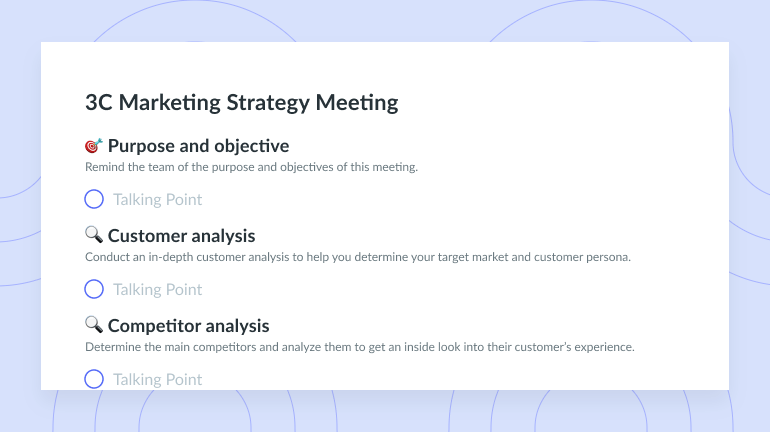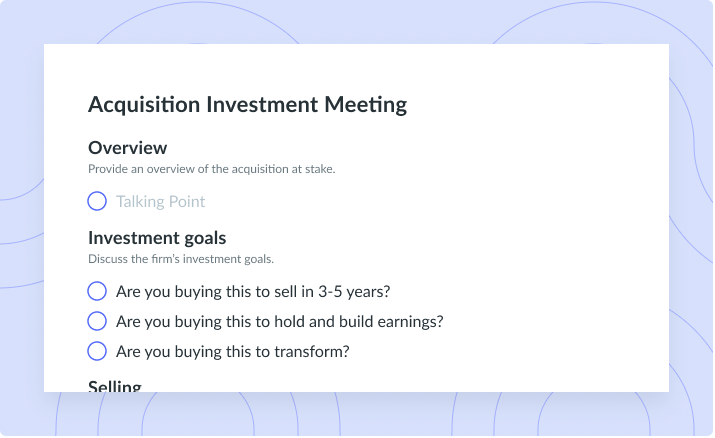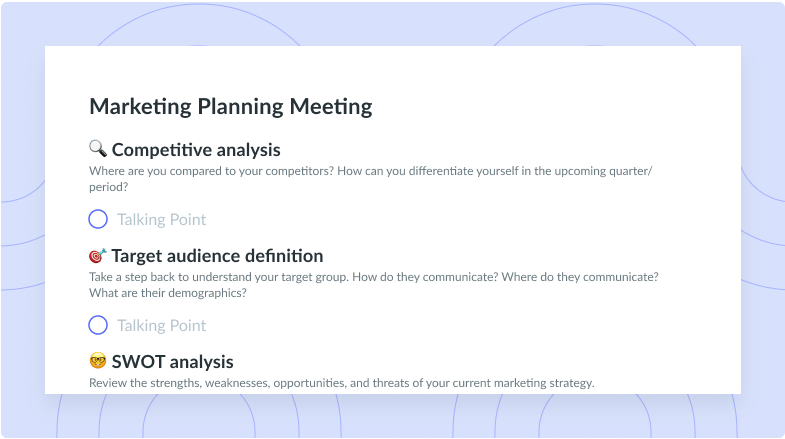Understanding Porter’s Five Forces Model and Why It Matters
Be ready to take on Porter's Five Forces with our breakdown and examples of the model.
It’s the end of the month. You and your team have worked tirelessly to do good work, hit all your benchmarks, and reach all your deadlines. It was exhausting, but you did it. You could say the same for all the months before.
And yet, despite it all, you’re still not where you want to be. What gives?
Porter’s Five Forces can help you find the answer. Get to know them – and how you can use them – with this in-depth guide.
- What are Porter’s Five Forces?
- What is the importance of Porter’s Five Forces?
- Understanding Porter’s Five Forces
- Examples of Porter’s Five Forces
What are Porter’s Five Forces?
Porter’s Five Forces are:
- Current industry competition
- Potential new competition
- Supplier bargaining power
- Customer bargaining power
- Potential for substitute products
Through an analysis of Porter’s Five Forces, you can establish whether your company will be more or less profitable than others in its market. Your analysis will tell you where your business stands relative to your competition.
Notably, Porter’s Five Forces are used as a macro business analysis tool. They look at everything surrounding you in your industry rather than what’s going on behind your doors. For a combined macro and micro business analysis, couple a SWOT analysis with Porter’s Five Forces.

Pro tip
Use a meeting management tool like Fellow to take digital, collaborative notes in Fellow’s stream feature to achieve your goals and move forward.
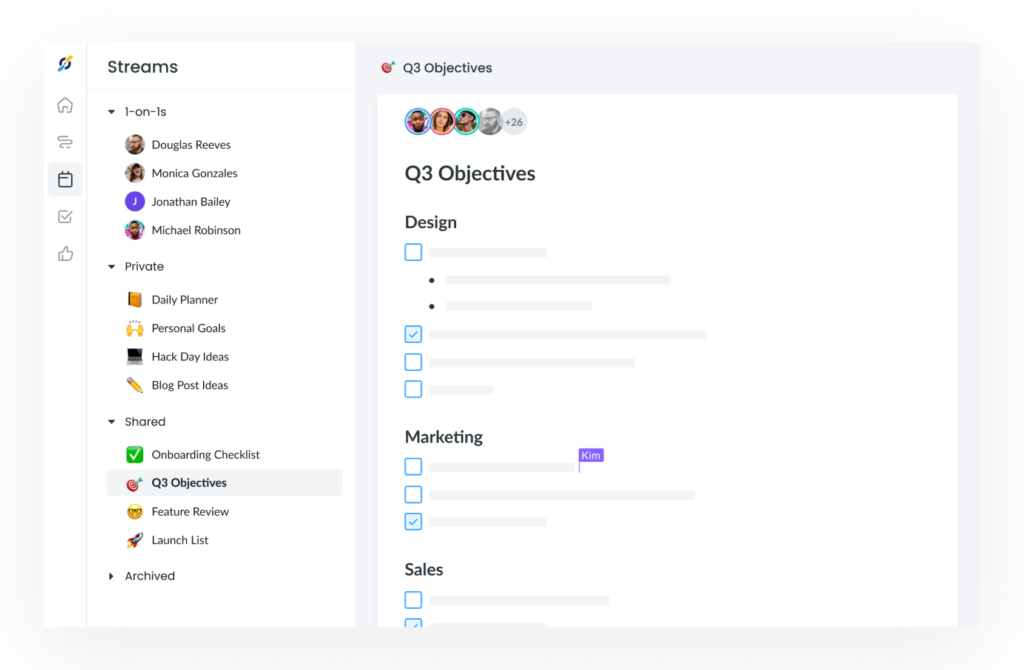
Wait, so who is Porter?
The “Porter” in the Five Forces is Michael Porter, a Harvard Business School professor who identified the five forces in 1979. His words in the Harvard Business Review point to the main objective of his game-changing model:
“Understanding the competitive forces, and their underlying causes, reveals the roots of an industry’s current profitability while providing a framework for anticipating and influencing competition (and profitability) over time.”
What is the importance of Porter’s Five Forces?
Yes, Porter’s Five Forces are more than 40 years old, but they remain relevant today. As long as more than one company offers similar products or services to the same market, Porter’s Five Forces will always matter.
You should care about Porter’s Five Forces because they’re your guide to figuring out how changes in your industry could affect your company. When you know how certain trends and outlooks about your industry affect your bottom line, you can adjust your operations accordingly.
How exactly these forces influence your business decisions is easier to explain once you know what each force means. We’ll get into that all below.
Understanding Porter’s Five Forces
Porter’s Five Forces aren’t exactly self-explanatory, but they’re not as complicated or jargon-heavy as they might initially seem. Here, we’ll break down all this complex lingo in simpler terms:
- Current industry competition
- Potential new competition
- Supplier bargaining power
- Customer bargaining power
- Potential for substitute products
1 Current industry competition
This force looks at how many competitors your business has and what they can do that you can’t (or vice versa). When you have more competitors, you have less power in your market. Your competition will also be more intense if your customers or clients could potentially switch to a business like yours without spending much. Periods of industry-wide growth can also drive competition.
Now, we’ll admit it: The above tenets of your current industry competition can make things seem all doom-and-gloom. In reality, that’s not quite the case. You can also take the above as advice for how to succeed when there’s low competition. In that case, you have way more power, and customers or clients would have to spend a lot to switch. As such, you’ll face fewer obstacles adjusting your prices and negotiating contracts that favor your business.
2 Potential new competition
In theory, there’s always potential new competition. In reality, you only need to worry about this concern if you’re in an industry with low barriers to starting a business. If your competitors, whether current or future ones, could eat away at your market share without spending much time or money, that’s a concern. If doing so would require a huge amount of resources, then this force should work in your favor.
To determine whether there are large barriers to industry access, think about how you got started. Did you need an especially strong brand identity? Lots of capital? Tons of money? If the answer to all these questions is yes, your industry’s entry barriers are high. If not, you should view the potential of new entrants as a realistic threat.
3 Supplier bargaining power
When you pay less to get the raw materials, supplies, and services you need, your business is more profitable. This concept somewhat speaks for itself: The higher your expenses, the less of your revenue you keep, so the less profit you earn. On the other hand, a closer look at the supplier marketplace is necessary to understand this force.
Let’s say you only have a few choices of suppliers for a certain raw material you use. In that case, each supplier has formidable bargaining power. Don’t like the supplier’s prices or contracts? Well, you only have so many other choices, and your cost of switching is probably high. Conversely, when you have a wealth of suppliers from which to choose, each one’s bargaining power is diminished. If you don’t like one of them, you can always go elsewhere.
4Customer bargaining power
As a small business owner, you might think that you and only you set your prices. In reality, your prices reflect market conditions, which include the number of customers buying your products.
If you have fewer customers, each one is of more value to your business, and losing them would do more harm to your bottom line. As such, these customers could theoretically demand price changes in ways to which you can’t really object. Conversely, if you have lots of customers, one person can’t quite exert this bargaining power, and you’ll probably be fine if you lose them.
Market conditions pertinent to customer bargaining power also include the cost of acquiring new customers. Savvy customers might thus realize that you’ll spend far more if you lose them than if you keep them around. They also might use this fact as a base from which to bargain. Seriously – customers can hold immense power.
5 Potential for substitute products
If other companies offer products or services like yours, then according to Porter’s Five Forces, there’s always a chance your customers will switch. This rule concerns more than your obvious competition. It pertains to the existence of any product or service that could theoretically replace yours.
When your company has fewer potential substitutes, you have more power. Customers can’t quite go elsewhere to find what they need – you’re one of few options. (Or maybe you’re the only option! If so, you’re really doing it right!) Conversely, when you have more substitutes to contend with, you can’t as easily retain customers. That’s especially true if the cost of switching is low or the companies behind the substitutes have more marketing resources than you do.
Examples of Porter’s Five Forces
Maybe Porter’s Five Forces sound new and unusual to you. Plot twist: They’re around you all the time, every day. In fact, every time you choose between buying from a small business or household name, you’re proving the veracity of Porter’s Five Forces. Below are examples for each force to show you how this is true.
- Current industry competition. Your local pharmacy will always face competition from pharmacy chains like CVS, Walgreens, or Rite Aid. These megaliths have far greater resources available to them than the pharmacy around the corner. So when you choose Walgreens over the local pharmacy, it’s not like the latter can just offer you discounts to keep you around. Walgreens, though, has more than enough profits to do exactly that.
- Potential new competition. The same local pharmacy might be lucky enough to exist somewhere free of chain pharmacies. But that local pharmacy will always be wary of the big names’ constant goals of – and resources for – expansion. If a CVS opens up nearby, the pristine look, bigger public profile, and larger space can draw customers in ways impossible for small pharmacies to achieve.
- Supplier bargaining power. Many of the prescriptions that a pharmacy sells only have one manufacturer (well, at least until they go generic). That means these manufacturers can set their prices however they please, and pharmacies have no choice but to follow suit. If you’ve ever paid what you thought was way too much for a prescription, you’ve seen this principle in action. Individual pharmacies might have little power to sell for less.
- Customer bargaining power. A small local pharmacy might not have as many medications readily on hand as, say, Rite Aid. Additionally, Rite Aid, given its greater profits, might sell a certain prescription for less than the small pharmacy. Customers at the small pharmacy probably realize the pharmacy has fewer customers and may try to use Rite Aid’s price as leverage to pay less.
- Potential for substitute products. Pharmacies don’t face as many substitute threats. Only so many drugs can address the same issue, and only so many businesses in an area have legal licensure to sell drugs. That said, substitute threats exist elsewhere in the pharmacy world. Drug manufacturers deal with the prospect of substitution any time something they manufacture goes generic.
May the forces be with you
At your next strategy meeting, discuss how to face the challenges that Porter’s Five Forces present. Your team might have solutions you could never have dreamed of, even if you’re more knowledgeable about your competitors and suppliers. Show up with a meeting agenda that allows time to discuss each force. You can use Fellow to write this agenda and make the most of your time. After your meeting, you should be ready to take on even the biggest forces.









